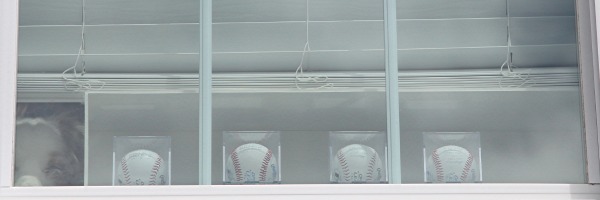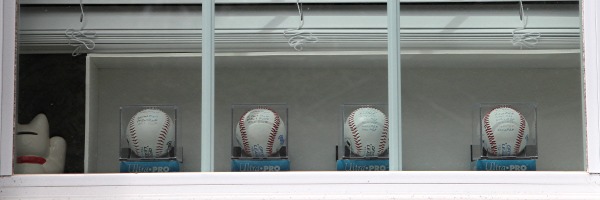Now we’re getting serious
Like anyone with a big stack of autographed baseballs, the last thing I want to see happen to them is for the autograph to fade away to nothing over time. Unfortunately, there isn’t much literature out there on this problem, just collections of anecdotes. Over the past year, I’ve conducted a couple of tests to help make sense of the mechanisms involved and give me an idea of where to go next. With the preliminary research out of the way, it’s time to go full-scale and test the key variables to finally answer the question of what a baseball should be signed with. To get up to speed, start with these posts:
Faded Memories in Ink on Leather
Synthetic Leather Baseball Ink Test Phase 2
Baseball Ink Test Preliminary Results
Disclaimers
But first, let’s go over what I’m not accounting for. One concern that this test will not resolve is about the effect of different pen pressures and stroke styles on the longevity of a signature. Theoretically, an autopen setup could be used to carefully control these aspects of the test, but I don’t have one. Also, these factors are out of the control of the receivers of an autograph, so I’m not sure what could be gained. This is an area where this test will fall short of full technical rigor and I would be negligent if I failed to point that out.
Also beyond the scope of this experiment is the effect on temperature and humidity on the different aspects of this process. These factors could significantly affect the flow of ink from the pen, the application of the ink to the ball, and the durability of the ink over time. Environmental conditions will be the same for the initial application of all ink and will be the same within each test location, though these locations will not be maintained to guarantee identical conditions between locations. Some variation is accepted as a limitation of this test.
Test Configuration
With that, we have enough of an understanding of the problem to put together a final comprehensive test to identify the best pens to use on either synthetic or natural leather baseballs.
Test Surface
The surfaces used in this testing will be Rawlings CROLB (natural leather, $3.09/1) lot #ERBA2 and OLB3 (synthetic leather, $12.99/6) lot #EOBA5 baseballs. Results from this testing should be applicable to any other Rawlings baseball using one of these two surfaces, including official MLB baseballs (same surface material as the CROLB), though this has not been confirmed and may not hold true (spoiler: it doesn’t). Rawlings also makes baseballs with a composite leather cover but those will not be used in this test. All baseballs used were purchased at retail (Target) in March of 2014.
Test Environment
All baseballs exposed to light will be enclosed in an Ultra PRO UV Protected Ball Holder. All ball holders used were purchased at retail in March of 2014 ($3 each at local hobby store). Each ball in a holder will also have a corresponding control ball with identical markings kept in darkness directly beneath the exposed ball. Control balls will be enclosed inside the box from from the ball holder to provide an equivalent environment with light as the only variable; a napkin will be placed over the ball to prevent direct contact between the ink and any hard surface and to block any stray light that might get in around the box lid.
Three different lighting conditions will be used: full direct sunlight (southern facing windowsill), partial direct sunlight (eastern facing windowsill), and indirect sunlight (on the top of my stack of autographed baseballs). To prevent indoor lighting from contaminating either of the windowsill locations, enclosures will be placed around the test area (this will also prevent accidental disturbance of the test areas). The third test location is in a room with incandescent lights but fluorescent light is present elsewhere in the house. This will be considered a representative display location and no effort will be taken to block artificial light. All balls in holders will be tilted to the same angle to ensure that all inks are exposed to similar lighting (angles of incidence will unavoidably vary but should not be a factor with the extreme level of sunlight exposure involved).
Inks Tested
Inks to be tested will fall into two categories: ballpoint and porous point. All ballpoints will be blue medium point from different manufacturers covering a range of price points from cheap bulk pens to high-end refills. Porous point pens will include both black and blue versions of each brand tested, when possible. All ballpoints and the Staedtler, Bic, and Pentel porous point pens were purchased at retail in March of 2014. The Sharpie porous point pens were purchased in 2013 and the Pilot and PaperMate porous point pens are at least a decade old (these are only being used because it was not feasible to obtain new samples at retail). Details of the pens used are as follows.
Bulk Ballpoints
Bic Round Stic $1.69/12
Purchased from Amazon.com in March of 2014.
PaperMate Write Bros. $1.99/12
Purchased from Amazon.com in March of 2014
Retractable Ballpoints
Pentel RSVP $4.00/5 (sale)
Purchased at Staples in March of 2014.
Pilot EasyTouch $1.99/2
Purchased at Stop and Shop in March of 2014.
Refill Ballpoints
Zebra F301 Refill $1.99/2
Purchased from Amazon.com in March of 2014
Cross Refill $5.79/2
Purchased from Amazon.com in March of 2014
Parker QuinkFlow Refill $6.29/1
Purchased at Staples in March of 2014.
Leeds 9092-12RF Refill $0.76/1
Purchased from leedsworldrefill.com in March of 2014
Porous Point Pens
Sharpie Pen (blue and black) $5.09/3 (assorted colors)
Purchased at Target in 2013.
Bic Intensity .5mm (blue and black) $5.99/5 (assorted colors)
Purchased at Staples in March of 2014.
Staedtler Fineliner .3mm (blue and black) $11.49/10 (assorted colors)
Purchased at Staples in March of 2014.
Pentel Finito (blue and black) $6.49/6 (assorted colors)
Purchased at Staples in March of 2014.
Pilot Razor Point (blue and black)
Unknown purchase date/location.
PaperMate (black)
Unknown purchase date/location.
PaperMate Liquid Expresso (blue)
Unknown purchase date/location.
Decision Analysis Process
Before we get to the test itself, we need to understand what we’re looking for and how to evaluate it. We’ll start with what is expected of the ink and then define some metrics to evaluate the performance of each pen against our requirements. The final result will be a set of scores to measure relative performance of each pen and identify strengths and weaknesses.
Requirements
The goal of this experiment is to find the ideal pen to use when getting signatures on baseballs. This pen will need to be able to put a quality signature down on the surface of the ball, maintain the integrity of that signature until it can be put on display, and retain a quality signature while on display indefinitely.
Signature Application
When it comes to the original signature, the pen needs to lay down an even layer of ink through every stroke. This means no gaps or light spots and no pooling or dripping. Pressure could be a factor here but is not something that we will be able to test this time around. Our first performance metric will therefore be Ink Coverage.
Ink Stability
The next challenge after getting the signature onto the surface of the ball is keeping it intact until it can get to a storage or display location. Some amount of handling, including direct contact with the signature, must be assumed. In order for the signature to remain undamaged, the ink must dry sufficiently in a short period of time, probably less than a minute, under the full range of normal environmental conditions (temperature, humidity, etc.). Again, these factors provide a range of possibilities that exceed this particular test configuration. Relative resistance to smudging under the same conditions will be as much as this test can evaluate with the performance metric of Smudge Resistance.
Display Performance
Once the signed ball has reached its permanent location, it needs to be possible to put it on display in a typical display environment without suffering damage that renders the signature unreadable. The use of a plastic ball cube is assumed to be a component of the typical display environment. The primary mechanism of degradation in this environment is fading due to light exposure. The performance metric of Fade Resistance will take into consideration the effects of direct and indirect sunlight exposure and the effects of a mixed natural/artificial light environment. No specific evaluations of different types of artificial lighting will be performed at this time.
Storage Performance
Another possible destination for an autographed baseball is storage in a dark location. Previous testing has indicated that the primary mechanism of degradation in this environment is bleeding, giving us the final performance metric of Bleed Resistance.
Evaluation Method
Each of the four performance metrics will be assessed separately on a High/Medium/Low scale for each ink/surface combination. A High rating will be worth 20 points, a Medium rating will be worth 10 points, and a Low rating will be worth 0 points, for a maximum possible score of 80. The option(s) with the highest total score will be the preferred options, with advantages and disadvantages explained to allow for evaluation of suitability for specific uses. In the event of a tie, preference will be given to the option with the highest minimum rating (10/20/10/20 will outperform 20/20/20/0).
Next Up: Initial Photos and Ink Coverage


Comments are closed.